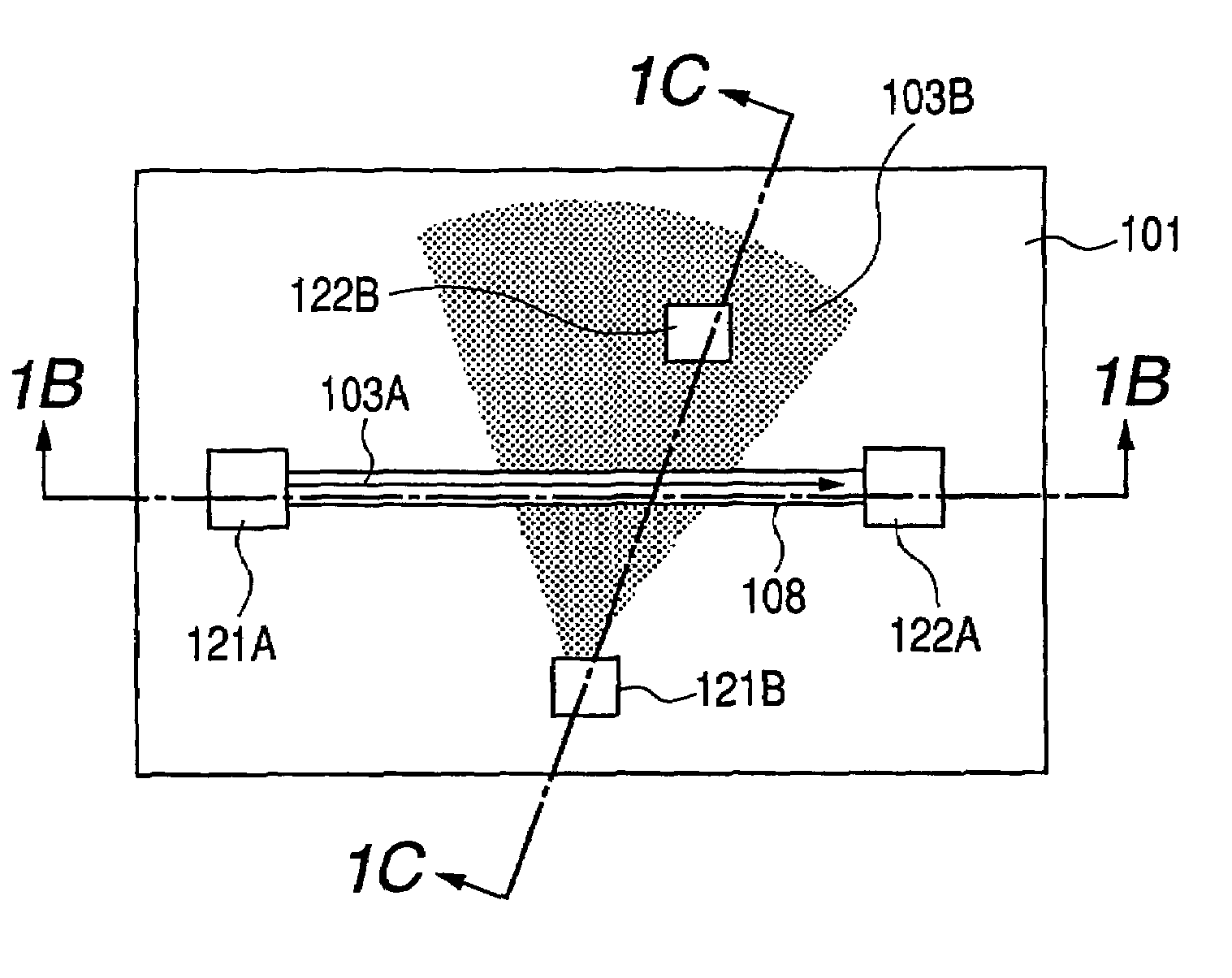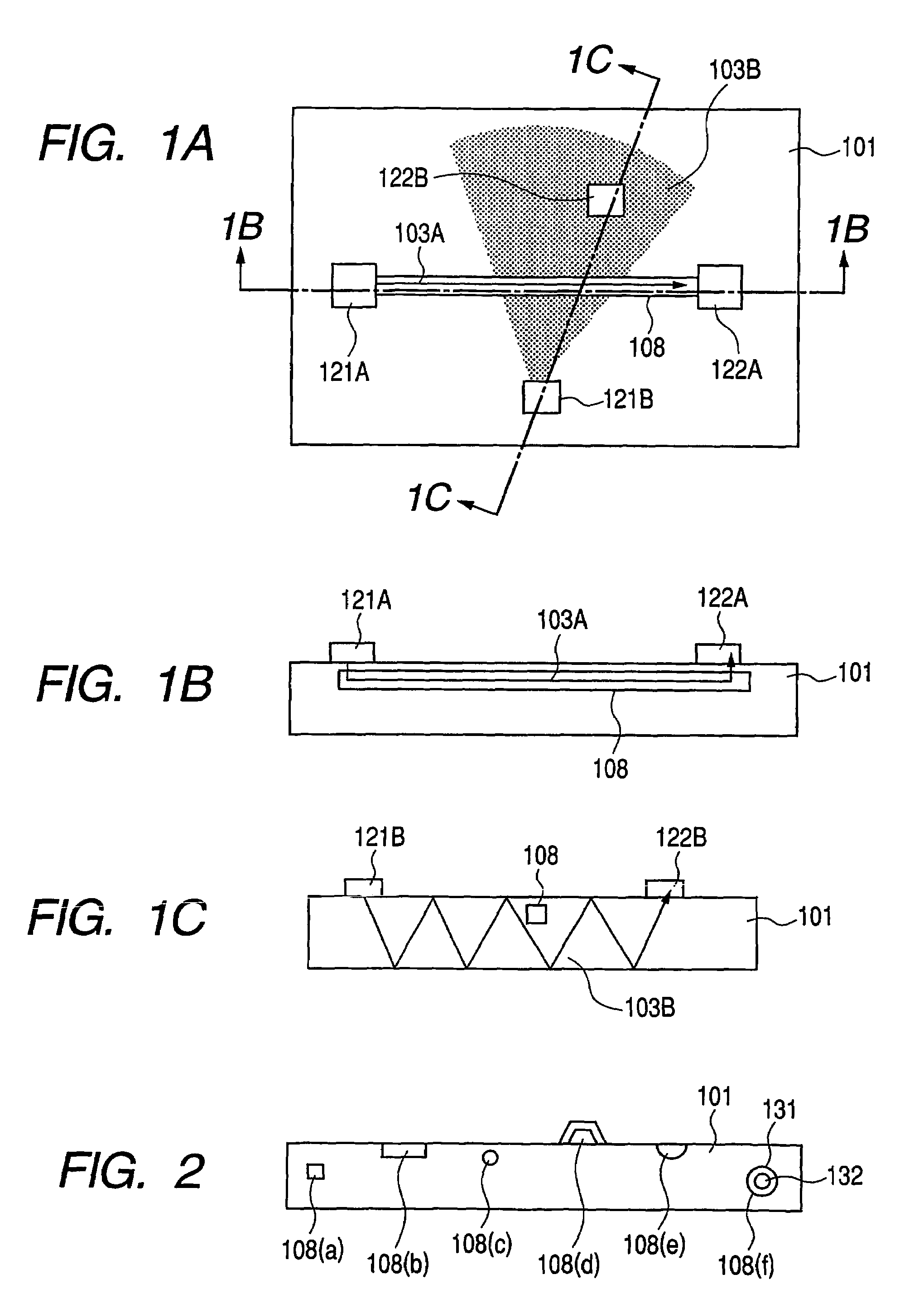Optoelectronic circuit board with optical waveguide and optical backplane
a technology of optoelectronic circuit boards and backplanes, applied in the direction of optical waveguide light guides, optical elements, instruments, etc., can solve the problems of wire-attributable delays and emis, line waveguides, and difficulty in aligning optical axes, etc., to achieve high speed/operation flexibility
- Summary
- Abstract
- Description
- Claims
- Application Information
AI Technical Summary
Benefits of technology
Problems solved by technology
Method used
Image
Examples
example 1
[0064]In Example 1, an optical transmission device having a configuration similar to that of FIGS. 1A through 1C is prepared. In this example, the optical transmission medium 101 is made of fluorinated polyimide (refractive index: about 1.55) and has dimensions of 3 cm×5 cm. A single linear line waveguide 108 is buried so as to run horizontally in the optical transmission medium 101 as shown in FIGS. 1A through 1C. The line waveguide 108 shows a square cross section like that of 108(a) in FIG. 2 and each of the sides is about 25 microns long.
[0065]The refractive index of the line waveguide 108 is greater than that of the surrounding non-line section by about 1%. While both the line waveguide and the non-line section are made of fluorinated polyimide, their refractive indexes can be differentiated by differentiating the respective fluorine contents. The illustrated structure is formed by forming a film layer of fluorinated polyimide that makes the non-line section on a substrate, sub...
example 2
[0071]In Example 2, an optical transmission device having a configuration similar to that of FIGS. 4A and 4B is prepared. FIGS. 4A and 4B show plan views of the same arrangement. In this example, the optical transmission medium 101 is made of PMMA (refractive index: about 1.49) and optical fibers of quartz of a single mode are buried in the optical transmission medium 101 for line waveguides 108. The optical fibers show a cross section similar to that of 108(f) in FIG. 2. Thus, the cores 132 of the optical fibers operate as line waveguides 108 and the clad sections 131 of the optical fibers and the surrounding PMMA operate as non-line section.
[0072]The cores and the clad sections of the optical fibers show respective diameters of about 10 μm and about 125 μm and a relative refractive index of 0.2%. Since the optical transmission medium 101, or the PMMA layer, has a thickness of 200 μm, it can be used as a multi-mode two-dimensional optical waveguide, whereas the line waveguides 108 ...
example 3
[0079]In Example 3, an optical transmission device having a configuration similar to that of FIG. 5 is prepared. An optical transmission medium 101 having a configuration similar to that of its counterpart of Example 1 is also used in this example. In this example, the optical transmission medium 101 has a size of 3 cm square and is provided with optical ports 102 adapted to transmit and receive data signals by way of a plurality of line waveguides 108. A parallel transmission can be conducted between the ports that are linked together by way of a plurality of line waveguides 108. Apart from these ports, the optical transmission device additionally comprises a broadcast port 123 for broadcasting a clock signal. The optical signal 103B from the broadcast port 123 is propagated through the optical transmission medium that is a two-dimensional waveguide and received by the other ports 102.
[0080]Each of the ports 102 comprises an optical transmitter adapted to output light to the corres...
PUM
 Login to View More
Login to View More Abstract
Description
Claims
Application Information
 Login to View More
Login to View More - R&D
- Intellectual Property
- Life Sciences
- Materials
- Tech Scout
- Unparalleled Data Quality
- Higher Quality Content
- 60% Fewer Hallucinations
Browse by: Latest US Patents, China's latest patents, Technical Efficacy Thesaurus, Application Domain, Technology Topic, Popular Technical Reports.
© 2025 PatSnap. All rights reserved.Legal|Privacy policy|Modern Slavery Act Transparency Statement|Sitemap|About US| Contact US: help@patsnap.com



